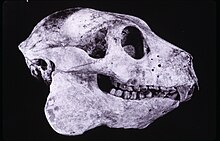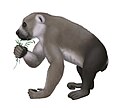Sloth lemur
| Sloth lemur Temporal range:
| |
|---|---|

| |
| Babakotia radofilai skull | |
| Scientific classification | |
| Domain: | Eukaryota |
| Kingdom: | Animalia |
| Phylum: | Chordata |
| Class: | Mammalia |
| Order: | Primates |
| Suborder: | Strepsirrhini |
| Superfamily: | Lemuroidea |
| Family: | †Palaeopropithecidae Tattersall, 1973[1] |
| Genera | |
The sloth lemurs (Palaeopropithecidae) comprise an
Diet
Members of the family Palaeopropithecidae appear to have eaten a mix of fruit, nuts, and foliage.
Distribution and diversity
Postcranial measurements and anatomy suggest that three of the four genera, Palaeopropithecus, Babakotia, and Mesopropithecus were primarily arboreal and suspensory.[5] The family was isolated due to river systems which formed a bio-geographical boundary, and likely attributed to the speciation of the family into four genera.[8]
Taxonomy
Traditionally the family Palaeopropithecidae has been considered most closely related to members of the extant family Indriidae based on morphology. Recently, DNA from extinct giant lemurs has confirmed this, as well as the fact that Malagasy primates in general share a common ancestor.[9] The post-canine teeth of sloth lemurs are similar in number (two premolars, three molars) and general design to living indriids. Babakotia and Mesopropithecus preserve the typical indriid-like toothcomb, but Palaeopropithecus and Archaeoindris have replaced it with four short and stout teeth of unknown functional significance.[4] The vertebrae formation supports the theory that three of the four genera were suspensory/arboreal, while Babakotia was more likely antipronograde.[10]
| Taxonomy of family Palaeopropithecidae[11]: Table 21.1 | Phylogeny of sloth lemurs and their closest relatives[12][13] | |||||||||||||||||||||
|---|---|---|---|---|---|---|---|---|---|---|---|---|---|---|---|---|---|---|---|---|---|---|
|
|
Extinction

The extinction of Palaeopropithecus (as well as other giant lemurs) has been linked to climate change and the subsequent collapse of ecosystems that come with rapid climate shift. Recent findings also indicate that human hunting is partly responsible for the extinction of giant lemurs. It is likely not the only cause and cannot be applied to the entire island of Madagascar, but does explain patterns in certain regions of human settlement.[14] Long bones have been discovered with cuts characteristic of butchering, either by dismembering and skinning or by filleting.[15] Thorough scrutiny has led scientists to believe these marks to be from hunting by early humans.[16]
-
Archaeoindris fontoynonti
-
Babakotia radofilai
-
Mesopropithecus globiceps
References
- ISBN 978-0-231-11013-6.
- ISBN 978-1-881173-88-5.
- ISBN 978-0-8018-6251-9.
- ^ PMID 12457853.
- ^ PMID 11038588.
- PMID 15337413.
- PMID 11983905.
- .
- PMID 15784742.
- PMID 25216795.
- ISBN 978-0-520-25721-4.
- PMID 18442367.
- ISBN 978-0-226-30306-2.
- PMID 20226497.
- S2CID 4834725.
- PMID 16225904.
External links
 Media related to Palaeopropithecidae at Wikimedia Commons
Media related to Palaeopropithecidae at Wikimedia Commons



